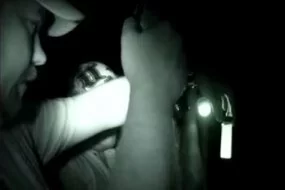We take a look at vintage ghost hunting equipment of old...
 With quite a few electronic gadgets being used by ghost investigators, some are implementing old-style ghost equipment for use or testing during investigations. What type of devices can we theorize might have been used by those attempting to detect paranormal activity a hundred or more years ago?
With quite a few electronic gadgets being used by ghost investigators, some are implementing old-style ghost equipment for use or testing during investigations. What type of devices can we theorize might have been used by those attempting to detect paranormal activity a hundred or more years ago?
Let's take a look at four potential pieces that can be purchased and added to the ghost equipment tool kit, that are not only interesting but might actually work better than their battery-powered counterparts. Tip: with a little research, some of this ghost equipment can be made at home for a real inexpensive addition to the toolkit!
The Compass
This piece of equipment is often overlooked for use in ghost detection due to not understanding how to work with it. The trusty old compass just may detect fluctuations in the electromagnetic field better than the EMF detector.
Advantages: Compasses not only fit in one's pocket with ease but are fairly inexpensive. It is easy to see the needle spin erratically or if the needle points in the wrong direction.
Theory: A compass should always point North due to the earth's gravitational pull. The compass will detect fluctuations in the electromagnetic field. Unseen energy changes, such as ghosts may produce, can alter the field, which will cause the compass needle to either point in the wrong direction or even spin.
Use: First find North with your compass and line the needle up with the painted arrow on the compass body. When moving about, keep the painted mark North at all times as comparison for the needle. Next, check the area of investigation for electrical lines, magnetic materials, or any other energy sources that could move the needle of the compass. During the investigation pay close attention for any movement of the needle. The needle will always maintain North during normal operation when still and level. North should never change direction, nor should the needle spin wildly, without being influenced by another energy source such as a ghost may produce. Always re-examine positive results of energy fluctuation to verify it is indeed paranormal.
Ghost Equipment Purchase: Compass prices start under $10 USD.
The Galileo Thermometer
This piece of ghost equipment is fantastic to watch work, as it is very visual with color and movement. It was invented by Galileo Galilei in the 1600's.
Being simple and fairly accurate, this thermometer has a sealed, glass tube filled with water and floating, colored, glass spheres. Attached to each different size sphere is a metal tag that serves as a counterweight and indicates a temperature. Each differs very slightly in density and it is the downward force of gravity that causes this thermometer operate. Differences in temperature changes the density of the water in the sealed, glass tube. The lowest floating glass sphere is the approximate temperature of the water.
Theory: As the temperature of the air outside the thermometer changes, so does the temperature of the water inside of the glass tube. Cold spots in an environment, as may be caused by ghost activity, may be visually detected by the Galileo Thermometer.
Use: Place several Galileo Thermometers around a haunted location, especially in specific areas known to have paranormal activity or develop cold spots. Allow the thermometers to adjust to the room temperature before investigating and take note. During the investigation, take notice of any differences in the thermometer readings, especially drastic changes. Galileo Thermometers can easily be watched from a single point in a room or by surveillance cameras observing several rooms with thermometers.
Ghost Equipment Purchase: Galileo Thermometer prices may start under $15 USD.
The Glass Barometer
This next piece of ghost equipment is simple, inexpensive, and like the Galileo Thermometer, it has the advantage of being able to be seen from across a room. The barometer was invented in 1643 by Evangelista Torricelli. A water-based barometer is also known as a "storm glass" or "Goethe Barometer" and are used to spot changes in atmospheric pressure, which can indicate short-term changes in weather.
Theory: Ghosts may cause a localized drop in atmospheric pressure, being detected as either a rise or fall by the barometer.
Use: The Glass Barometer is a sealed body, half filled with water. A narrow glass tube connects to the main glass body below the water level and rises above the glass body (and water level). When the air pressure is lower, the water level in the glass tube will rise above the water level in the body. When the air pressure is higher, the water level in the glass tube will drop below the water level in the glass body.
Similar to using the Galileo Thermometer, place several Glass Barometers around a haunted location and mark the water level of the glass tubes with a marker. During the ghost investigation, take note of any visible changes in the water level when compared with the line on the glass tube due to changes in atmospheric pressure. Drastic changes in atmospheric pressure may be observed from across a room or picked up by surveillance cameras.
Ghost Equipment Purchase: Glass Barometer prices may start under $10 USD.
Fitzroy Storm Glass
The find of our last piece of ghost equipment from the past must be credited to The Outlaw Ghost Hunter. Though experimental, the Fitzroy Storm Glass is indeed intriguing!
Admiral Robert FitzRoy developed this storm glass as a weather forecasting device. It was used on his voyage with Charles Darwin on the HMS Beagle. This storm glass is made up of a sealed glass container, filled with liquid a mixture of several ingredients, typically distilled water, ethanol, potassium nitrate, ammonium chloride, and camphor.
Fitzroy believed that when the liquid was clear, the weather should be clear. If the storm glass is cloudy, then perhaps the weather may be cloudy, an indicator of possible precipitation.
Theory: It was originally theorized that temperature and pressure changes affect the solubility of the chemicals within the super-saturated solution, resulting in either a clear liquid or crystals precipitating out of the liquid (or upon the glass). No one really knows how the device works and what it detects, however, though it has been theorized that the crystallization might occur due to changes in electrical charges on the glass walls.
As a ghost detection device, perhaps the Fitzroy Storm Glass may indicate changes in the electromagnetic field, similar to the compass.
Use: Place Fitzroy Storm Glasses in purportedly haunted environments and note their initial appearance. Watch for any changes that may occur during the ghost investigation. Changes in the Fitzroy Storm Glass may be visible from across a room or by surveillance equipment, possibly indicating ghost activity.
Ghost Equipment Purchase: Fitzroy Storm Glass prices may start under $40 USD

